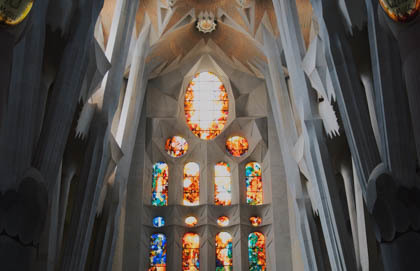I have been very blessed in my career as a graphic designer with the opportunity to design stamps for Canada Post. Since 2004, with the launch of a commemorative stamp marking the 125th anniversary of the Army Cadets in Canada, I have designed six stamp issues (13 stamps). And while every stamp issue has been a unique and positive experience,it did not prepare me for the adventure of the Christmas stamp issue for 2011 and 2012. But I am getting a little ahead of myself.
The assignment began with a phone call in July 2010 from the Canada Post Stamp Manager whom I work with. She asked if I would be interested in being part of the group proposing concepts for the Christmas issue—at 20 million stamps, it is the largest issue of the year. The stamps would feature four stained glass windows from the St. Mary's Cathedral in Kingston, Ont., which was celebrating its 150th anniversary at the end of 2011, coinciding with the release of these stamps. When I received the photography of the four pre-determined scenes, I was a bit taken aback. While the windows were spectacular, they were almost too much so. There was so much brilliant detail and ornamentation, it was hard to know where to focus your eye. As each scene resided within a group of six larger windows, the main focus of each of the subjects was lost. The four stamps were to feature the Angel speaking to Joseph, Mary and Joseph kneeling before Jesus, the Epiphany with Jesus receiving gifts, and Mary and Child.
I had a few thoughts about how to approach the project so as to put my best foot forward. I knew that if the other designers were using the same source materials, we were all facing the same challenge and would end up with similar designs. As Kingston is only about a 2½ hour drive east of Toronto, I decided a road trip was in order.
At the very least, I would get out onto the highway perhaps gain some insight into the stained glass windows environment. I contacted the church office to make the proper arrangements and made the journey to Kingston on a Saturday morning. I was told the entrance would be open and that I would need to be mindful as a florist would be setting up for an afternoon wedding. It was a beautiful summer day. Pulling up to the cathedral, I was struck by the contrast of the brilliant white lime-stone blocks against the cyan sky. The walls had massive, dark windows—about one to two dozen was my initial guess, though that fell far short of the actual number. I walked up the steps, opened a huge oak door and entered the foyer. The front area was very large and charmingly dated, with the exact scent you would expect from such an old building. I walked through the doors to the main cathedral and was blown away. I was struck by the architecture, the majesty of the building and the sheer number of windows. The glass that had appeared so dark and dreary from the outside (leaving me wondering if the trip was worth the effort) illuminated the church inside. Once I located the scenes I was there to capture—all at least 12 metres in the air—I took hundreds of photos upon which to base my designs.
After an hour or so spent scouting the rest of the church and taking photos of everything I could, I knew I had found what I was looking for. But just in case, I made a donation, lit a prayer candle, sat in the empty cathedral and said a prayer. Hey, you never know.
That was not the first time I was so taken by stained glass. I can remember as a kid, easily bored and not quite mature enough to follow along with the Mass (especially if we had arrived late and had to sit near the back of the church) that I would just stare at the windows of our old church. I thought about how special those people must have been to be featured on the stained glass and wondered what they had done to be immortalized on those windows. I also wondered how the glass artists knew what the people looked like and who would be so generous as to donate them to the church. But, mostly, I thought about how the windows could tell very complex sto-ries without words and how they spoke to people of different walks of life. (In doing research for these stamps, I have often seen stained glass windows referred to as the "Poor Man's Bible.")
So, with all the photography from my shoot downloaded, I spent the remainder of the summer creating design concepts that would speak of the beauty of the windows in the most unique way. One of the designs that stood out from the beginning used a series of decorative accent windows known as quatre-feuilles as backdrops for the individual scenes, which I isolated from the rest of the full window. With that as my first choice of the three designs I submitted, I waited to hear back from Canada Post.
As with other stamp issues, my designs were going to be reviewed and scrutinized along with the work of other designers by Canada Post's Stamp Advisory Committee. This group meets a few times a year to determine which stamps will be released through the Stamp Program during the course of the following 12 to 18 months. Late in October, I received another phone call from Canada Post telling me that my designs had been chosen and that I would need to move from concept phase to full production mode in short order.
It was in this second phase of the project that things became really interesting. That was when I met glass artist Mark Thompson, who had spent the better part of 20 years helping restore the stained glass in St. Mary's. He is not only a fantastic glass artist in his own right but also an expert in stained glass meth-odology and a historian. As it turns out, the windows at St. Mary's have quite a storied history and, ac-cording to Thompson's information, almost did not make it to their intended destination. The windows were manufactured and shipped from England but ended up in the United States in error. The only way they would be released to Canada was if a duty was paid. Sir John A. Macdonald, Canada's first prime minister, paid the tax from his own pocket—a nice gesture from the Anglican prime minister. Thompson was also the photographer of the original images supplied for the project, so he was a natural to help provide the professional photography for this project.
It didn't hurt that he had access to a scissor lift and was not afraid of heights.
Now, as this project wraps up after almost 2½ years, with the last stamp of the series released on October 15, I take away many things from the experience. One thing I learned is that inspiration can come from the most obvious places—be it from a church pew at a photo shoot or a church pew from my childhood. I also found that stained glass windows are a lot like stamp designs: God is in the details and it is in those details, sometimes very small, that we can make the most impact. Also, it seems stamp design can touch people in the same way stained glass was meant to, which is something I found out first-hand at the stamp launch at St. Mary's in November 2011. Many in at-tendance came up to me afterwards, touched by the immortalization of St. Mary's on a stamp and proud that people across Canada would bear witness to the beauty they see in their parish every Sunday. But I think the biggest thing I'll take away from this experi-ence is that, for the rest of my life, I don't think I'll ever look at a stained glass window the same way again.






